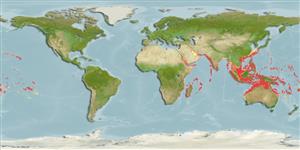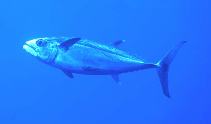Gymnosarda unicolor (Rüppell, 1836)
Dogtooth tuna
Waarneming toevoegen in Fish Watcher
| Native range | All suitable habitat | Point map | Year 2050 |

|
| This map was computer-generated and has not yet been reviewed. |
| Gymnosarda unicolor AquaMaps Data sources: GBIF OBIS |
Uploaden van uw Foto's en video's
Pictures | Videos | Google afbeeldingGymnosarda unicolor
Picture by Patzner, R.
Pictures | Videos | Google afbeeldingGymnosarda unicolor
Picture by Patzner, R.
Reunion Island [La] (La Réunion) country information
Common names:
[No common name]
Occurrence: native
Salinity: marine
Abundance: | Ref:
Importance: | Ref:
Aquaculture: | Ref:
Regulations: | Ref:
Uses: no uses
Comments: Also Ref. 53568.
National Checklist:
Country Information: https://www.cia.gov/library/publications/resources/the-world-factbook/geos/re.html
National Fisheries Authority:
Occurrences: Occurrences Point map
Main Ref: Collette, B.B. and C.E. Nauen, 1983
National Database:
Occurrence: native
Salinity: marine
Abundance: | Ref:
Importance: | Ref:
Aquaculture: | Ref:
Regulations: | Ref:
Uses: no uses
Comments: Also Ref. 53568.
National Checklist:
Country Information: https://www.cia.gov/library/publications/resources/the-world-factbook/geos/re.html
National Fisheries Authority:
Occurrences: Occurrences Point map
Main Ref: Collette, B.B. and C.E. Nauen, 1983
National Database:
Common names from other countries
Classificatie / Names Lokale namen | Synoniemen | Catalog of Fishes(Genus, Soort(en)) | ITIS | CoL | WoRMS | Cloffa
> Scombriformes (Mackerels) > Scombridae (Mackerels, tunas, bonitos) > Scombrinae
Etymology: Gymnosarda: Greek, gymnos = naked + Greek, sarde = sardine; 1598 (Ref. 45335).
More on author: Rüppell.
Etymology: Gymnosarda: Greek, gymnos = naked + Greek, sarde = sardine; 1598 (Ref. 45335).
More on author: Rüppell.
Environment: milieu / climate zone / depth range / distribution range Ecologie
marien rifbewoner; oceanodroom (Ref. 51243); diepte 0 - 250 m (Ref. 86942). Tropical; 20°C - 28°C (Ref. 5313); 31°N - 30°S, 32°E - 130°W (Ref. 168)
Verspreiding Landen | FAO regio's | Ecosystemen | Voorkomen | Point map | Introducties | Faunafri
Indo-Pacific: Red Sea and East Africa to French Polynesia, north to Japan, south to Australia.
Grootte / Gewicht / Leeftijd
Maturity: Lm ? range ? - ? cm
Max length : 248 cm FL mannelijk / geslacht onbekend; (Ref. 40637); common length : 190 cm NG mannelijk / geslacht onbekend; (Ref. 9710); max. gepubliceerd gewicht: 131.0 kg (Ref. 168)
Max length : 248 cm FL mannelijk / geslacht onbekend; (Ref. 40637); common length : 190 cm NG mannelijk / geslacht onbekend; (Ref. 9710); max. gepubliceerd gewicht: 131.0 kg (Ref. 168)
Korte beschrijving Determinatiesleutels | Morfologie | Morfometrie
Dorsale stekels (totaal) : 13 - 15; Dorsale zachte stralen (totaal) : 12 - 14; Anale stekels: 0; Anale zachte stralen: 12 - 13; Wervels: 38. This species is distinguished by the following characters: body elongate and moderately compressed; mouth fairly large, upper jaw reaching to middle of eye; 14 to 31 large, conical teeth on upper jaw, 10 to 24 on lower jaw; 2 patches of villiform teeth on upper surface of tongue; total gill rakers on first gill arch 11-14; D1 XIII-XV, its border almost straight, the second followed by 6-7 finlets, dorsal fins close together; anal fin followed by 6 finlets; pectoral fins with 25-28 rays; interpelvic process large and single; lateral line strongly undulating; body naked posterior to corselet except for lateral line, dorsal-fin base, and caudal keel; caudal peduncle slender, with a well-developed lateral keel between 2 smaller keels on each side. Colour of back and upper sides brilliant blue-black, lower sides and belly silvery; no lines, spots or other markings on body; anterior tip of first dorsal fin dark; other fins greyish (Ref. 9684).
An offshore species found mainly around coral reefs. Generally solitary or occur in small schools of six or less. Preys on small schooling fishes such as Decapterus, Caesio, Nasio, Cirrhilabrus, Pterocaesio and squids. Caught mainly by pole-and-line. Marketed canned and frozen (Ref. 9684, 48637). Adults may be ciguatoxic (Ref. 37816). Minimum depth reported taken from Ref. 128797.
Levenscyclus en paargedrag Maturiteit | Voortplanting | Paaien | Eieren | Fecunditeit | Larven
Hoofdreferentie
Upload your references | Referenties | Coördinator : Collette, Bruce B. | Medewerkers
Collette, B.B. and C.E. Nauen, 1983. FAO Species Catalogue. Vol. 2. Scombrids of the world. An annotated and illustrated catalogue of tunas, mackerels, bonitos and related species known to date. Rome: FAO. FAO Fish. Synop. 125(2):137 p. (Ref. 168)
Status op de Rode Lijst van het IUCN (Ref. 130435: Version 2024-2)
Niet bedreigd (LC) ; Date assessed: 01 March 2022
Gebruik door de mens
Visserij: van minder commercieel belang; sportvis: ja
FAO(visserij: productie; publication : search) | FishSource | Sea Around Us
Meer informatie
Population dynamics
Groeiparameters
Max. ages / sizes
Length-weight rel.
Length-length rel.
Lengtefrequenties
Massaconversie
Rekrutering
Abundantie
Groeiparameters
Max. ages / sizes
Length-weight rel.
Length-length rel.
Lengtefrequenties
Massaconversie
Rekrutering
Abundantie
Life cycle
Voortplanting
Maturiteit
Fecunditeit
Paaien
Spawning aggregations
Eieren
Ontwikkeling van de eieren
Larven
Larvale populatiedynamiek
Voortplanting
Maturiteit
Fecunditeit
Paaien
Spawning aggregations
Eieren
Ontwikkeling van de eieren
Larven
Larvale populatiedynamiek
Physiology
Body composition
Nutrients
Zuurstofverbruik
Zwemtype
Zwemsnelheid
Visual pigments
Fish sound
Diseases & Parasites
Toxicity (LC50s)
Body composition
Nutrients
Zuurstofverbruik
Zwemtype
Zwemsnelheid
Visual pigments
Fish sound
Diseases & Parasites
Toxicity (LC50s)
Genetics
Genetica
Heterozygosity
Erfelijkheid
Genetica
Heterozygosity
Erfelijkheid
Human related
Aquaculture systems
Aquacultuurprofielen
Kweeklijnen
Ciguatera cases
Stamps, coins, misc.
Aquaculture systems
Aquacultuurprofielen
Kweeklijnen
Ciguatera cases
Stamps, coins, misc.
Tools
Bio-Quiz | E-boek | Veldgids | Determinatiesleutels | Lengtefrequentie Tool | Levenscyclus tool | Verspreidingskaart | Classification Tree
| Catch-MSY |
Speciale rapporten
Bekijk gegevens voor het houden in een aquarium | Bekijk Fact Sheets voor de soort | Bekijk Aquacultuur Fact Sheets
Download XML
Internetbronnen
Aquatic Commons | BHL | Cloffa | Websites from users | Bekijk FishWatcher | CISTI | Catalog of Fishes(Genus, Soort(en)) | DiscoverLife | ECOTOX | Faunafri | Fishtrace | GenBank(genoom, nucleotide) | GloBI | GOBASE | | Google Books | Google Scholar | Google | IGFA World Record | MitoFish | Nationale databanken | Otolith Atlas of Taiwan Fishes | PubMed | Reef Life Survey | Scirus | SeaLifeBase | Tree of Life | Wikipedia(ga naar, zoek) | World Records Freshwater Fishing | Zoological Record
Estimates based on models
Preferred temperature (Ref. 115969): 20.9 - 28.2, mean 26.5 (based on 938 cells).
Fylogenetische diversiteitsindex (Ref. 82804): PD50 = 1.0000 [Uniqueness, from 0.5 = low to 2.0 = high].
Bayesian length-weight: a=0.01096 (0.00661 - 0.01818), b=3.06 (2.92 - 3.20), in cm Total Length, based on LWR estimates for this species & (Sub)family-body (Ref. 93245).
Trofisch niveau (Ref. 69278): 4.5 ±0.75 se; based on food items.
Weerstandsvermogen (Ref. 120179): laag, minimale populatieverdubbelingstijd 4,5-14 jaar (Assuming tmax>10).
Fishing Vulnerability (Ref. 59153): Very high vulnerability (90 of 100).
Climate Vulnerability (Ref. 125649): Very high vulnerability (92 of 100).




